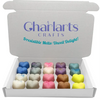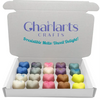A Guide to Cat-Safe Wax Melts

Introduction: Why Cat-Safe Wax Melts Matter
Creating a welcoming and fragrant atmosphere in our homes is essential for our comfort and relaxation. However, when sharing our living spaces with feline friends, it's crucial to consider the safety and health of our pets when selecting home fragrances. In this article, we'll explore cat-safe wax melts, discuss why they're important, and offer tips on how to maintain a cat-friendly, aromatic home.
The Hidden Dangers of Traditional Wax Melts for Cats
While traditional wax melts can fill a room with pleasant scents, they often contain ingredients that can be harmful to cats. These ingredients, such as paraffin wax, lead, benzene, and synthetic fragrances, can negatively impact your cat's respiratory and nervous systems.
Paraffin Wax: A Risk to Your Cat's Health
Paraffin wax, a petroleum by-product, releases toxic compounds when burned. These fumes can be harmful to both humans and pets, particularly if used regularly in poorly ventilated rooms.
Cat-Safe Alternatives: Beeswax, Soy Wax, and Plant-Based Wax Melts
To ensure your cat's safety and well-being, consider using wax melts made from beeswax, soy wax, or plant-based wax. These eco-friendly alternatives do not release toxic pollutants and generally burn longer than paraffin-based wax melts.
CharlartsCrafts is dedicated to providing cat-safe, environmentally responsible wax melts crafted from plant-based wax.
Keeping Your Cat Safe: Tips for a Cat-Friendly Home Fragrance Experience
When using wax melts in a home with cats, follow these guidelines to keep your feline friend safe:
1. Choose Fragrances Wisely
Cats have a strong sense of smell and can be sensitive to certain fragrances. Avoid wax melts containing ingredients that can be harmful to cats, such as:
- Wintergreen
- Sweet birch
- Citrus (d-limonene)
- Pine
- Ylang ylang
- Peppermint
- Cinnamon
- Pennyroyal
- Clove
- Eucalyptus
- Tea tree (melaleuca)
- Thyme
- Oregano
- Lavender
2. Prevent Accidents and Injuries
Cats are curious creatures and may attempt to investigate or play with wax melt burners. To prevent accidents, keep wax melts and burners out of reach, and never leave a lit candle or wax melt burner unattended.
3. Prioritize Proper Ventilation
Ensure your home is well-ventilated when using wax melts, particularly if your cat has a respiratory condition like asthma or chronic bronchitis. Good air circulation helps dissipate fumes and keeps the environment fresh and comfortable for both you and your pets.
Conclusion: By selecting cat-safe wax melts and taking precautions to protect your feline friend, you can create a comfortable, welcoming, and fragrant home without compromising your cat's health. Opt for eco-friendly alternatives like beeswax, soy wax, or plant-based wax melts, and follow the guidelines outlined in this article to maintain a cat-friendly, aromatic home.




